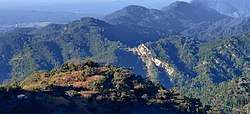Kipling Trail
Kipling Trail (also known as Kipling Road) is the old walking route that connects Dehradun with the hill station of Mussoorie in India. It was the only means of reaching Mussoorie before the cart roads, for tongas, or roads for automobiles were constructed. It is named after the English novelist Rudyard Kipling, who is believed to have walked the trail in the 1880s.[1] The trail fell out of use when cars or buses became the preferred mode of transport, but the route is being revived by nature, colonial history and hiking enthusiasts.[2]
| Kipling Trail | |
|---|---|
 View of the Doon Valley | |
| Length | 5.5 miles (8.9 km) |
| Location | Uttarakhand |
| Trailheads | Shahanshahi Ashram, Rajpur, Dehradun |
| Use | Hiking |
| Elevation | |
| Highest point | Mussoorie, 2,005 m (6,578 ft) |
| Hiking details | |
| Trail difficulty | Moderate to Strenuous |
| Season | All year |
| Sights | Doon Valley, diverse bird species, woodland flowers, Bougainvillea, Quercus leucotrichophora oaks |
| Hazards | Steep in places with forty-degree incline |
History

In the 1880s, novelist Rudyard Kipling trekked this trail and captured the experience in his novel Kim.[1] With the construction of an asphalt road in the early 20th-century, going right up to Mussoorie, the heritage walking route gradually fell out of favour. Today, the path is being revived as it is increasingly being used by hikers and nature or history enthusiasts, who prefer walking up to the hill station over driving.[3] In his book The Kipling Road, author Ruskin Bond explores the many stories of people who walked the old route from Rajpur to Mussoorie.[4]
Route
The 9 km-trail takes between 2 and 3 hours to complete, and begins at Shahanshai Ashram in Rajpur village, Dehradun. It winds its way up through five steep inclines that are locally called paanch kainchi, Hindi for "five scissors".[2] The halfway point is at Jharipani, which is surrounded by Quercus leucotrichophora or banjh oak forests.[5] The path then leads to Barlowganj near St George's College, Mussoorie, then goes past Wynberg Allen School, finally reaching Mussoorie Library.[3] Along the route lies an old railway tunnel, remnant of a failed project, and British-era rest houses. In 2017, parts of the trail were cemented without providing necessary outlets for drainage, and it was reported that road construction was "ruining the path's beauty".[6] There were protests by the public, stating that vehicular traffic would harm the biodiversity along the route and change the nature of the heritage path.[6]
References
- "Kipling Road to Mussoorie: Nature lovers revive trail, much to Ruskin Bond's joy". Hindustan Times. August 12, 2017.
- "Uttarakhand: Walking the Doon Valley".
- "Hike up the Kipling trail, slow food demo and more on 2nd day of Rajpur Nature Festival | Dehradun News - Times of India". The Times of India.
- "The Kipling Road | Rupa Publications".
- "Ruskin Bond on retracing the footsteps of Rudyard Kipling in the hills of India". www.dailyo.in.
- "'With construction and road repair work, the Jharipani trek has lost its charm' | Dehradun News - Times of India". The Times of India.